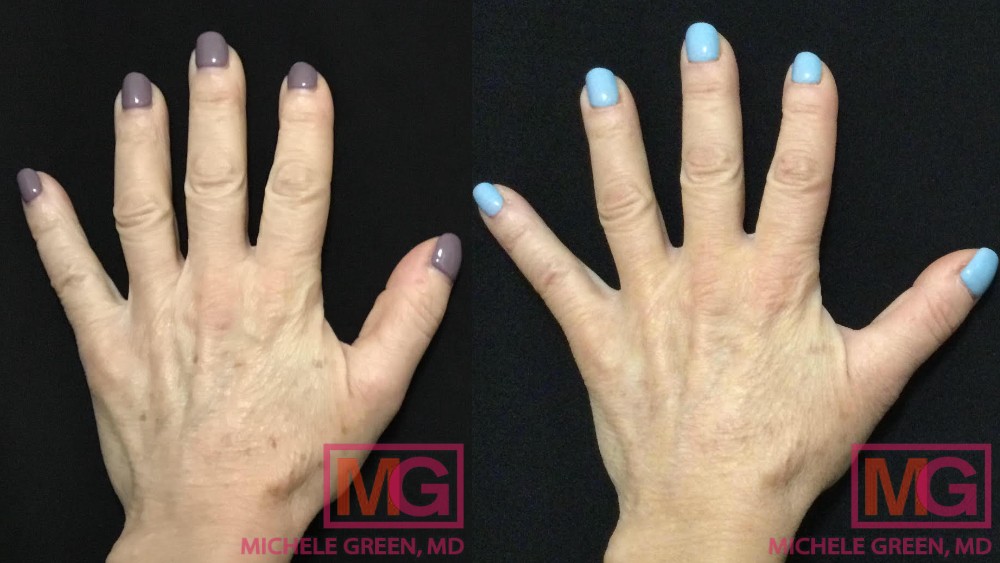Age Spots and Liver Spots Treatment
As we age, visible signs of aging and sun damage become noticeable on our skin. In addition to fine lines and wrinkles, one of the most obvious indicators of aging is sun spots, also known as “liver spots,” solar lentigines, or “age spots.” Liver spots form due to prolonged sun exposure that accumulates over time. Unlike freckles, which may fade, liver spots tend to merge, grow larger, and become more noticeable. While these flat, circular, tan spots are harmless, they can be cosmetically concerning since they appear in highly visible areas, including the face, neck, hands, chest, shoulders, arms, and back. Cosmetic dermatologist Dr. Michele Green, based in New York City, specializes in removing unwanted liver spots, melasma, uneven skin tone, and other types of hyperpigmentation in patients of all skin types and tones.
There are many treatment options for removing liver spots. These treatments aim to eliminate unwanted pigmentation and encourage the production of new collagen, which helps make the skin look healthier and younger. Some options include Fraxel, Clear + Brilliant, Alex-TriVantage, Intense Pulsed Light (IPL), microneedling, TCA peels, Mesopeels, and Cosmelan. Prescription-strength bleaching creams like hydroquinone and targeted skincare products can also reduce melanin production and fade pigmentation. When choosing a liver spot treatment, it’s best to consult a board-certified dermatologist, such as Dr. Michele Green, who can help you find the best plan to achieve clear, radiant, and long-lasting skin.
Dr. Michele Green is a board-certified dermatologist who has treated patients with liver spots and other unwanted skin pigmentation issues at her Upper East Side office in New York City for over 25 years. An expert in chemical peels, laser treatments, and skincare, Dr. Green has consistently been recognized as one of the top healthcare providers in New York by New York Magazine, Castle Connolly, The New York Times, and Super Doctors. She has developed a line of skincare products with MGSKINLABS Inc. to promote healthy skin and reduce pigmentation and sun damage. Dr. Green takes a holistic approach to cosmetic dermatology, customizing each patient’s treatment plans to their specific concerns and goals. Whether dealing with liver spots, melasma, generalized hyperpigmentation, or uneven skin tone, Dr. Green is dedicated to helping.
What is a liver spot?
Liver spots, also known as age spots, sun spots, or solar lentigines, are small, flat, round, and brown patches that develop from prolonged exposure to the sun’s ultraviolet (UV) rays. A liver spot forms over time as your body’s way of protecting itself from sun damage. The term “liver spot” is a misleading misnomer because these spots are not related to the liver’s function; they are caused by sun damage. The most common areas where liver spots appear are parts of the body frequently exposed to sunlight, such as the face, hands, shoulders, and arms. These spots are very common, and their occurrence increases with age. Over time, liver spots can grow larger and may even merge. While liver spots are harmless, they can be removed for cosmetic reasons if you’re unhappy with their appearance.
What liver spots look like
Liver spots are small, flat, oval dark spots on the skin. They are usually tan or dark brown and can cluster together. Some liver spots are small and resemble freckles, while others can be as large as half an inch in diameter. Caused by too much sun exposure, age spots typically develop in people over 50; however, intense sun exposure during youth can also lead to age spots appearing in younger individuals. Sometimes, pigmented areas like freckles can merge, forming liver spots and giving the skin a mottled look. Unlike freckles in children, which fade over time, age spots stay on the skin, giving a speckled appearance.
The cause of liver spots
Although “liver” is used in its name, these melanin-rich spots do not develop due to liver function or vitamin and mineral deficiencies. Liver spots are caused directly by prolonged sun exposure. UV rays are harmful to the skin, damaging DNA at a cellular level and leading to signs of premature aging. The melanocytes (pigment-producing cells) in the outer layer of the skin produce a pigment called melanin to absorb UV rays and protect the skin from sun damage. When people are exposed to direct sunlight, the body responds by overproducing pigment to absorb UV rays, resulting in the formation of melanin-rich lesions, also known as liver spots, on areas with the most sun exposure, such as the face, hands, and arms, where protective clothing is typically not worn.
How to treat liver spots on the skin, face, and hands
Liver spots, also called age spots or sunspots, can be treated with various methods, including topical creams, cosmetic procedures, and lasers. Excessive sun exposure and harmful UV rays are the main causes of liver spot development. While liver spots are harmless and usually don’t need treatment, they can make us look older. Fortunately, liver spots can be treated with many of the same methods used for age spots on the face. Laser resurfacing treatments, such as those using Fraxel and Alex TriVantage lasers, help remove liver spots on the face and can also treat the backs of the hands. The best treatment to remove age spots depends on the type and severity of the spots, as well as your skin type and tone. Topical treatments often contain hydroquinone or retinoids to lighten the spots, while procedures like laser therapy, cryotherapy, or chemical peels can remove or reduce the spots more quickly. For safe treatment and removal of liver spots, it’s best to consult a board-certified dermatologist, such as Dr. Green. With over 25 years of experience treating age spots and sun damage, she will work with you to create a personalized treatment plan.
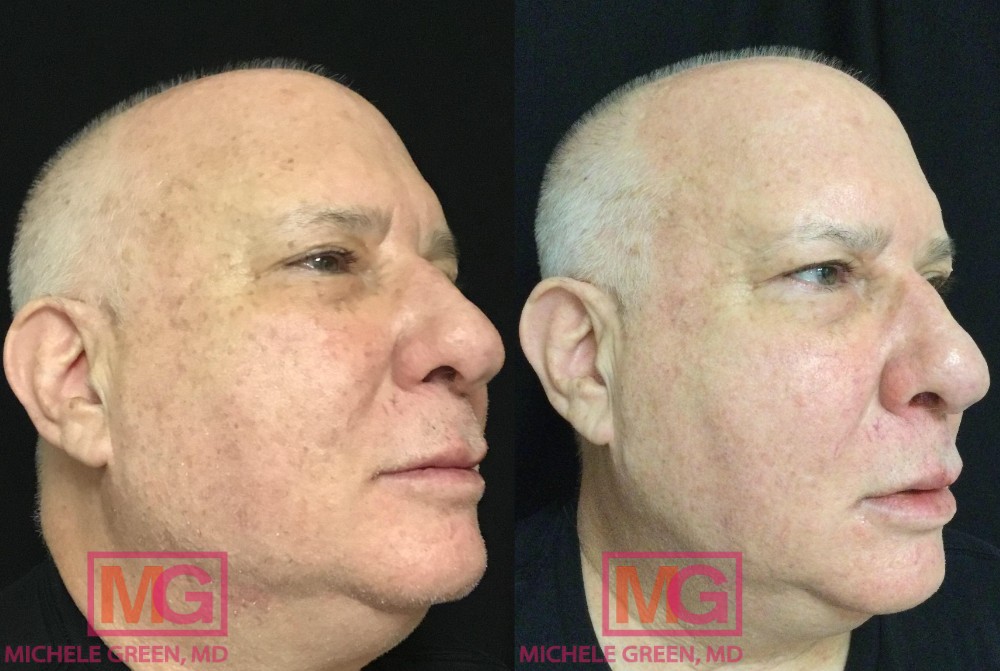
Laser treatments for liver spot removal
Candela Alex TriVantage Laser
The Candela Alex TriVantage Laser is designed to target discreet, localized liver spots. It is an Nd: Yag laser that removes pigmented lesions with minimal discomfort and little recovery time. During the procedure, the laser emits wavelengths of light into the dermis, which are absorbed by the melanin-rich lesions. This light energy converts into heat, destroying the pigmentation and allowing healthier, lighter skin cells to surface. The laser specifically targets pigmented cells, leaving the surrounding skin unaffected. Results become visible 1 to 2 weeks after the treatment. Depending on the darkness of the sunspot, you may require one or two sessions to remove the discoloration and unwanted pigmentation completely. If a second treatment is necessary, a one-month interval is recommended for the skin to heal completely between sessions. Besides removing liver spots, the Alex TriVantage laser effectively clears black, blue, and green pigmented tattoos.
Fraxel Dual Laser
The Fraxel Dual laser treatment was one of the first fractionated lasers to be FDA-approved for treating sun damage, sun spots, and liver spots. The laser has two wavelengths: a 1927nm setting to treat liver spots, lentigos, hyperpigmentation, and actinic keratoses, and a 1550nm setting to treat acne scars, fine lines, wrinkles, and uneven texture. The Fraxel laser creates thousands of controlled, microscopic injuries to the skin, stimulating its natural healing process and promoting collagen synthesis and the growth of new, smooth skin cells. When using the 1927nm wavelength setting, the Fraxel Laser targets and destroys melanin in pigmented cells, while leaving the surrounding skin unaffected. For this reason, Fraxel Lasers are best suited for patients with lighter skin (Fitzpatrick Skin Types I-III) to minimize unnecessary side effects in patients with darker skin tones. Depending on the degree of pigmentation, the number of sunspots, and the extent of sun damage, you may require three Fraxel laser treatments to remove all unwanted pigmentation. Each Fraxel laser treatment should be scheduled one month apart for optimal cosmetic results. For patients with darker skin tones, the Clear + Brilliant laser may be a more appropriate option for removing unwanted liver and sun spots.
Clear + Brilliant Laser
The Clear + Brilliant Laser, often referred to as the “mini-Fraxel” laser, is a gentle resurfacing procedure that gradually diminishes pigmentation, sun damage, liver spots, and age spots. With this treatment, patients can expect skin rejuvenation and reduced pigmentation as the laser’s fractionated energy targets melanin-rich lesions and stimulates collagen production for healthier, new skin. The Clear + Brilliant Laser is also beneficial because it is gentle enough for nearly all skin types, from light to darker tones, and is safe and effective for everyone. Although results are visible almost immediately after treatment, Dr. Green recommends five to six sessions spaced one month apart, depending on the severity, to achieve optimal results. There is no downtime following the procedure, and patients can return to their daily routines without any side effects.
Intense Pulsed Light (IPL)
Intense Pulsed Light (IPL) therapy, also known as photorejuvenation or photofacial, uses wavelengths of light to treat pigmentation and fine lines, enhancing the skin’s texture and feel. Unlike most lasers that use a single wavelength, IPL treatments employ multiple wavelengths to address signs of aging on different levels. When the IPL device is applied to the skin, it emits a light wavelength that penetrates the dermis and is absorbed by the melanin-rich lesion. The pigmented cells responsible for the liver spot convert the light energy into heat, destroying the pigmented cells, stimulating new collagen production, and fostering the growth of healthy skin. IPL treatment is generally painless and requires no downtime afterward. Multiple sessions spaced about a month apart are often necessary to achieve optimal cosmetic results.
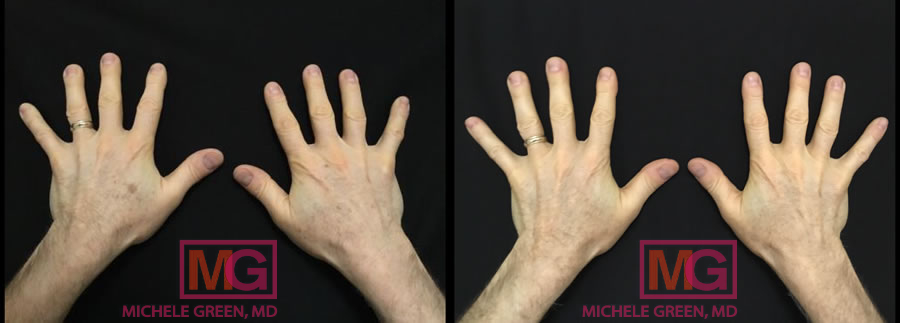
Chemical Peels for liver spot treatment
Trichloroacetic (TCA) Peels
A TCA peel involves applying trichloroacetic acid, a chemical solution, to the skin to remove the top layer of dead, pigmented skin cells. Removing these dead and pigmented cells stimulates the production of new skin, resulting in a more even, brighter, and healthier appearance. Different strengths of TCA can be used depending on the severity of the pigmentation and the patient’s skin type and tone. Besides eliminating liver spots, TCA peels can improve skin texture, fine lines, wrinkles, acne scars, enlarged pores, and other visible signs of aging. Patients might need five or six peels to achieve optimal cosmetic results. TCA peels are not recommended for individuals with darker skin tones due to the higher risk of post-peel discoloration.
Cosmelan Peels
The Cosmelan peel effectively reduces the appearance of melasma, liver spots, and post-inflammatory hyperpigmentation for a clearer, brighter complexion. Cosmelan is a medical-grade chemical peel that uses a proprietary blend of ingredients to eliminate discoloration and stimulate the growth of healthier skin. The peel exfoliates dead, pigmented cells from the skin, prevents further melanin buildup, and inhibits melanocytes from moving to the skin’s surface. The peel is applied at Dr. Green’s office and left on for a specified time based on your skin type and pigmentation. This treatment will cause initial peeling, which reduces pigmentation on your face. The peel is then rinsed off with a gentle cleanser. After the Cosmelan peel, Dr. Green will recommend a skincare routine with skin-lightening creams to improve the results. It’s important to use sunscreen and practice proper sun protection to prevent further sun damage and pigmentation.
Mesopeels
Mesopeels are chemical peels specifically designed to treat hyperpigmentation in sensitive areas. The Mesopeel works like other chemical peels to gently exfoliate the skin, removing dead skin cells and creating new collagen for rejuvenated skin. Unlike the Cosmelan peel, which is left on the skin for several hours, Mesopeels are left on for a matter of minutes before being removed, and the duration of application varies depending on the treatment area. Mesopeels can be applied to many areas, including the face, neck, chest, back, arms, and hands. Patients sensitive to the Cosmelan peel can easily tolerate Mesopeels, as its formulation is much gentler on the skin. Typically, four to six treatments are necessary to achieve the best results. There is no downtime, and patients can resume their daily activities immediately following the procedure. Following the Mesopeel procedure, Dr. Green may also prescribe lotions and creams from her MGSKINLABS, Inc. line of products for the best and lasting results.
Microneedling to eliminate liver spots
Microneedling, also known as collagen induction therapy, is an additional treatment option available at Dr. Green’s office for removing liver spots and pigmentation, as well as enhancing skin texture, reducing acne scars, and minimizing fine lines and wrinkles. The procedure involves puncturing the skin with tiny microneedles, creating a series of micro-injuries in the targeted area. The body responds to these small wounds by producing new collagen, resulting in smoother, healthier, and brighter skin. Another benefit of microneedling is that it enables topical skincare products to penetrate more deeply into the skin. Dr. Green often uses a depigmentation serum during the treatment to lighten and soften hyperpigmentation and liver spots. This serum contains various skin-brightening agents that reduce melanocyte activity and help eliminate liver spots. The procedure is painless, and Dr. Green applies a topical numbing cream to minimize discomfort. For optimal results, she recommends about three microneedling sessions spaced approximately one month apart.
Microdermabrasion for liver spots
Microdermabrasion is a non-invasive procedure that gently exfoliates the skin to remove pigmentation, including liver spots. Traditional microdermabrasion treatments use aluminum oxide or sodium bicarbonate crystals to sand away the top layer of skin, while diamond microdermabrasion employs a diamond-tipped handpiece for exfoliation. As dead, pigmented skin cells are “buffed” off, healthy, new skin can surface. Besides reducing pigmentation, microdermabrasion can enhance skin texture, fine lines, acne scars, and other skin issues. Patients may need multiple treatments to achieve the best cosmetic results.
HydraFacials for liver spots
A HydraFacial is a three-step process that rejuvenates the skin and addresses issues such as pigmentation, acne, and redness. It is safe and effective for all skin tones. The treatment uses patented vortex technology to cleanse, exfoliate, and nourish the skin. During the cleansing and exfoliating steps, beta- and alpha-hydroxy acids such as salicylic and glycolic acid remove dead skin cells, excess oil, and other impurities from clogged pores. Afterwards, nourishing ingredients like hyaluronic acid and peptides help hydrate the skin. Targeted boosters can be added to address specific skin concerns. Boosters like HydraFacial Brighten or Murad Vita-C deliver antioxidants and skin-brightening ingredients to reduce the appearance of liver spots. The procedure involves no downtime, and Dr. Green often recommends a series of treatments to achieve optimal results.
Topical skincare products for liver spot treatment
With numerous topical skincare products advertised for reducing pigmentation, it can be difficult to determine which one is best for you. Fortunately, Dr. Green is here to help. When you consult with Dr. Green at her private NYC dermatology office, she will develop a personalized skincare plan to support your in-office treatments and help you achieve and maintain clear, radiant skin. Dr. Michele Green has created a comprehensive line of products, including skin-lightening lotions and creams, designed to improve skin tone and texture, reduce sun damage, and address liver spots. She also incorporates prescription topical treatments, such as hydroquinone or retinoids, into her patients’ plans to eliminate liver spots and brighten the skin.
Founded by internationally renowned board-certified dermatologist Dr. Michele Green, MGSKINLABS offers a range of skincare options to treat age spots and prevent the further development of hyperpigmentation. The Vita-C Serum contains a high potency of vitamin C and is not irritating to the skin. Vitamin C is a powerful antioxidant that increases skin cell turnover, protects against oxidative stress, and reduces pigmentation and liver spots. MGSKINLAB’s Skin Brightening Cream is another fantastic product that contains skin-lightening ingredients like kojic acid and fruit extracts to lighten the skin and eliminate pigmentation.
Dr. Green may suggest using hydroquinone, a topical skin-lightening cream, as part of your skincare routine. Hydroquinone inhibits melanin production and prevents melanocytes from moving to the upper layers of the skin. It can only be obtained with a prescription from a board-certified dermatologist. However, it can cause skin irritation, especially in people with sensitive skin. Therefore, wearing sunscreen and avoiding sun exposure are crucial when using hydroquinone, as it can increase photosensitivity.
Retinoids are another effective prescription cream for eliminating liver spots. Retinoids are derived from vitamin A and work to enhance skin cell turnover, sloughing off dead, pigmented cells to reveal new, bright skin cells underneath. Retinoids also enhance collagen production to improve skin texture and promote skin rejuvenation. Proper sun protection should be adhered to when using retinoids, as the product can make the skin sensitive to the sun. Retinoids, such as Retin-A and tretinoin, are only available by prescription from a board-certified dermatologist. Retinols, however, are available over the counter. Dr. Green’s MGSKINLAB skincare line carries an Essential Antioxidant Infusion serum packed with retinol, vitamins C and E, and other nutrients to exfoliate and replenish the skin.
The most important skincare product to use while treating liver spots is sunscreen. Sunscreen is essential for maintaining treatment results and preventing further pigmentation and damage from the sun’s harmful UV rays. Dr. Green recommends using a broad-spectrum sunscreen with an SPF of at least 50 to protect from UVA and UVB rays. The Hydrating SPF 50 from MGSKINLABs is an excellent sunscreen that utilizes zinc oxide to protect against the sun, as well as hyaluronic acid and lactic acid to soften and nourish the skin. Dr. Green also recommends layering a chemical and physical sunscreen on the skin for maximum protection. Chemical sunscreens use ingredients like avobenzone and homosalate to absorb harmful UV rays and convert them into heat energy. Physical sunscreens use ingredients like zinc oxide and titanium dioxide to create a protective barrier on the skin and reflect UV rays.
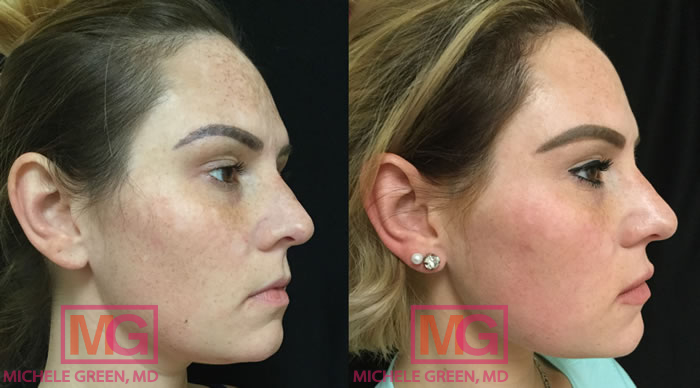
Frequently Asked Questions (FAQs) for liver spot treatment
Can liver spots fade?
Some liver spots can fade naturally over time. However, most require cosmetic treatment to remove them. Melanocytes (pigment-producing cells) in the outer layer of the skin produce a pigment called melanin to absorb UV rays and protect the skin from sun damage. When exposed to direct sunlight, the body responds by overproducing pigment, which leads to the formation of melanin-rich lesions, known as liver spots, on areas with the most sun exposure, such as the face, hands, and arms—places where protective clothing is usually not worn. Liver spots can fade with topical treatments, cosmetic procedures, or laser treatments, but they generally won’t disappear without some form of intervention.
What is the best treatment for liver spots?
There are many treatments for liver spots, including topical hydroquinone, retinoids, laser therapy, chemical peels, intense pulsed light (IPL), microdermabrasion, and cryotherapy. However, no treatment is universally regarded as the best. The most appropriate treatment for you depends on your skin type, tone, and the size of the spot. Dr. Green is a board-certified dermatologist with over 25 years of experience in treating liver and sun spots, and scheduling a consultation with her will help identify the best option for your needs.
What creams can be applied to liver spots to improve their appearance?
Prescription-strength creams with hydroquinone and tretinoin can treat liver spots. Hydroquinone functions as a bleaching agent, helping to lighten excess melanin in the skin. Tretinoin, a vitamin A derivative, increases skin cell turnover, allowing damaged cells to shed and potentially lighten the spot. Other effective over-the-counter options include vitamin C serums, which are antioxidants that help protect and brighten the skin. Additionally, tranexamic acid is an ingredient with a brightening effect, gradually helping to lighten liver spots. Most importantly, applying sunscreen to sun-exposed areas is essential to protect your skin and prevent further damage and the development of future liver spots.
What are the risk factors for developing liver spots?
Liver spots, also known as dark spots or age spots, are common, particularly among individuals over 50. However, certain risk factors can increase your chances of developing them over time. Liver spots typically form due to sun damage; individuals who have had intense or frequent exposure to the sun or tanning beds are more likely to develop these spots. Additionally, individuals with a history of severe sunburns are at higher risk of experiencing dark spots on their skin. Skin type or tone is another factor. Individuals with fair skin typically have less melanin, making them more susceptible to this discoloration. However, people with darker skin tones are also vulnerable to sun exposure and can develop sun spots and facial melasma.
Are liver spots permanent?
Liver spots are generally considered permanent. These spots are primarily caused by prolonged exposure to the sun’s UV rays, leading to an overproduction of melanin in the skin. As this excess melanin accumulates in specific areas, flat, brown, gray, or black spots begin to form. While these spots do not pose any health risks, they typically do not resolve on their own without treatment. Many people choose to have these spots removed for cosmetic reasons, using topical treatments, cosmetic procedures, laser therapy, or cryotherapy with liquid nitrogen. When considering the removal of a liver spot, it’s best to consult with a board-certified dermatologist, such as Dr. Green, to identify the most appropriate treatment for you.
Are liver spots dangerous?
No, liver spots are not dangerous and are only a cosmetic concern. However, signs of skin cancer lesions, including melanoma, can resemble liver spots. Malignant melanoma is the most serious type of skin cancer that develops within melanocytes. The ABCDE rule is used in dermatology to identify unusual moles that may indicate melanoma or other skin cancers. Dermatologists examine for asymmetry, irregular borders, color changes, a diameter larger than 6 millimeters, and whether the lesion is evolving in terms of size, color, or shape. If you notice a new dark lesion and are unsure if it is a liver spot or skin cancer, it’s best to have it examined by a board-certified dermatologist, such as Dr. Green in NYC. Dr. Green can visually evaluate any growths, moles, and dark spots to determine if they are liver spots or if a biopsy or other treatments are needed. This is especially important if there is a family history of skin cancer.
Can liver spots naturally go away?
Unfortunately, liver spots generally do not disappear on their own. They develop over many years of sun exposure and become more noticeable with age, growing and merging to form larger, more noticeable spots. To remove liver spots, a combination of cosmetic dermatological procedures such as chemical peels, microneedling, or laser treatments, along with targeted skincare products and skin-lightening creams, is typically required.
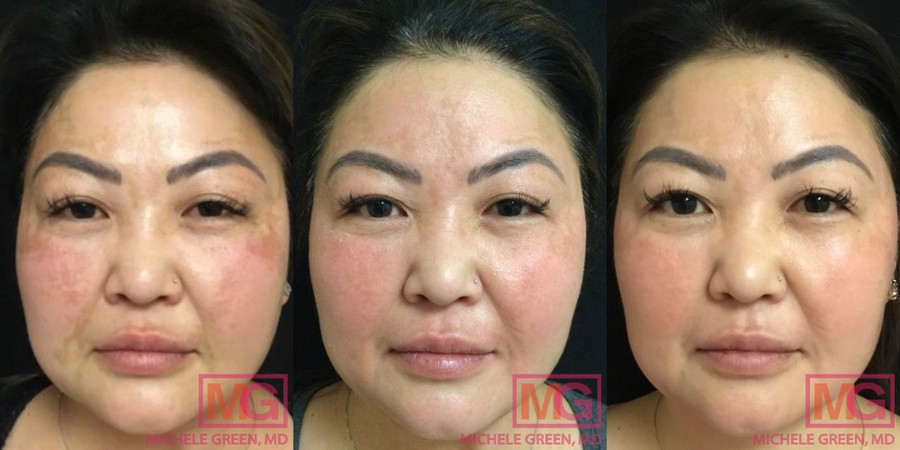
What can be used to treat age spots/liver spots?
If you want your age spots to be less noticeable, various treatments are available to lighten or reduce their appearance. Since the pigment is located at the base of the epidermis, the outermost layer of the skin, any treatments aimed at lightening age spots must penetrate this layer. Topical treatments for liver spots include bleaching creams containing hydroquinone and retinoids such as tretinoin, which may help fade the spots over time. When using these ingredients, especially bleaching agents like hydroquinone, it’s best to consult your board-certified dermatologist and use them under their supervision to avoid hyperpigmentation or hypopigmentation in other areas. Chemical peels can also be an excellent option for those with darker skin tones. The Mesopeel is a chemical solution applied to the skin to exfoliate and remove damaged outer layers, revealing smoother, more evenly toned skin underneath. Another effective treatment is laser therapy, such as the AlexTriVantage, Fraxel Dual laser, and Clear + Brilliant laser, which help physically break down the pigment and reduce the appearance of these liver spots. These lasers target melanin-rich lesions to break down the pigmentation, allowing healthier, lighter skin cells to emerge. With numerous procedures available to help treat liver spots, it is best to consult with a board-certified dermatologist like Dr. Green to assess your liver spots and develop the best plan suited for you.
Can liver spots be reversed?
Yes. The melanocytes in the outer layer of the skin produce a pigment called melanin to absorb UV rays and protect the skin from sun damage. When people are exposed to direct sunlight, the body responds by overproducing pigment to block UV rays, which leads to the formation of melanin-rich spots, also known as liver spots, on areas with the most sun exposure, such as the face, hands, and arms, where protective clothing is usually not worn. Once a liver spot forms because of excess melanin, it can be reversed through various procedures. Cosmetic treatments for removing liver spots include laser therapy, IPL treatment, chemical peels, HydraFacials, microneedling, and a combination of skin-lightening creams and lotions containing kojic acid, hydroquinones, and tranexamic acid.
Does skin color influence the choice of treatment for removing liver spots?
Yes! Skin color and skin type are crucial factors when selecting the most effective treatment for removing liver spots, age spots, and solar lentigines. Certain laser treatments target and destroy melanin, the pigment responsible for skin and hair color. Age spots form from an overproduction of melanin caused by sun exposure, resulting in dark spots. People with darker skin tones naturally have more melanin, which makes them less suitable candidates for some laser treatments, as the laser could target healthy skin and potentially cause burns or worsen hyperpigmentation. Additionally, darker skin is more prone to post-inflammatory hyperpigmentation, so treatments like Fraxel should be avoided. Instead, individuals with darker skin might prefer topical options such as chemical peels, Cosmelan peels, Mesopeels, microneedling, or skin-lightening creams like hydroquinone, which are more appropriate. Chemical peels, such as the Mesopeel and Cosmelan peel, are solutions applied to the skin to exfoliate and remove damaged outer layers, gradually smoothing and evening out the skin tone. Both peels are gentle and specially formulated to treat hyperpigmentation on various parts of the body. To reduce the risk of unwanted side effects, it’s best to consult a board-certified dermatologist, like Dr. Michele Green, at her Upper East Side office, who has extensive experience with all skin types and can develop a safe and effective treatment plan tailored to your needs.
How to prevent liver spots
Liver spots, also known as age spots, are common in individuals with lighter skin tones and can be prevented with proper sun protection. Dr. Green recommends practicing strict sun avoidance to prevent sunspot formation. Patients should always wear a broad-spectrum sunscreen with an SPF of 50 or higher when outside. Sunscreen should be reapplied every two hours or after water activities, even during rain or snow, since UV rays can penetrate clouds and reflect off snow. For full protection, patients prone to liver spots should layer both a physical and chemical sunscreen. Additionally, staying in the shade, wearing a wide-brimmed hat, and choosing tightly woven clothing can help protect the skin from the sun.
What do liver spots mean?
Patients in Dr. Green’s office always ask, “Why do people get liver spots?” Liver spots indicate that a patient was exposed to UV rays without protection – either from the sun or commercial tanning beds – resulting in hyperpigmentation on the skin. Liver spots are not dangerous and are not a sign of skin cancer. However, some patients dislike the appearance of liver spots and opt to have them removed with the assistance of a board-certified dermatologist, such as Dr. Green. If you are concerned about a pigmentation area on your skin, the best course of action is to schedule a consultation with a dermatologist who can examine the spot.
Do liver spots mean liver problems?
The origin of the term “liver spots” is unclear, but it is now seen as a misnomer. Liver spots are not related to the liver’s function at all. Some believe the name came from the idea that they were connected to the liver, but there is no such link. Others think the name was given because of their liver-like color. Nonetheless, the name is still used and can be swapped with terms like sun spots or age spots, which result from extended sun exposure and do not indicate any liver issues.
Do liver spots itch?
Liver or age spots are harmless and not cancerous, and they usually don’t cause itching or pain. However, if you notice a new dark spot that concerns you, have it checked by an experienced, board-certified dermatologist like Dr. Green. Dr. Green will examine the dark spot visually to determine if it is a liver spot or another skin condition. If a dark spot is bleeding, has irregular borders, changes in size, darkens, or itches, it’s best to have Dr. Green carefully evaluate it and possibly biopsy it to prevent the growth from becoming cancerous.
Can you laser liver spots?
Yes! Lasers are a popular treatment at Dr. Michele Green’s private NYC dermatology office for removing liver spots. Some lasers used for this purpose include the AlexTriVantage laser, the Fraxel Dual laser, and the Clear + Brilliant laser. The AlexTriVantage laser emits light wavelengths into the dermis, breaking down pigmentation and allowing healthier, lighter skin cells to surface. The Fraxel laser creates thousands of controlled, microscopic injuries to stimulate the skin’s natural healing process, encourage collagen production, and promote the growth of new, smooth skin cells while also destroying melanin in pigmented areas. The Clear + Brilliant Laser, often called the “mini-Fraxel” laser, targets melanin-rich lesions and stimulates collagen production for healthier skin. To determine which laser is best suited for your skin, it’s advisable to consult with a board-certified dermatologist, such as Dr. Green.
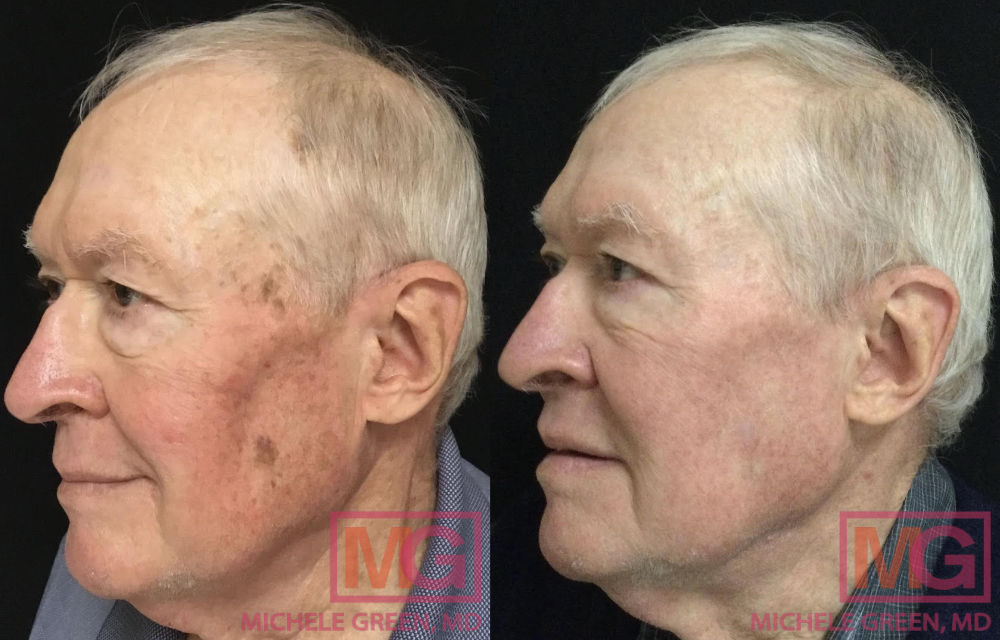
How to treat liver spots naturally?
Liver spots don’t disappear on their own and usually require a procedure or skin-brightening cream. Some treatments can be done at home to help diminish the appearance of liver spots. Many people swear by aloe vera, as some compounds in aloe vera have been shown to brighten the skin. Green tea is also used to treat liver spots due to its antioxidant properties. While natural remedies at home might have some effect on reducing liver spots, these methods haven’t been fully studied for safety or effectiveness. It’s best to consult a board-certified dermatologist, such as Dr. Green, for the most effective treatment. An expert in cosmetic dermatology, Dr. Green has over 25 years of experience treating liver spots with laser treatments and chemical peels and will work with you to create a personalized treatment plan to help you achieve clear, glowing skin.
How can you avoid liver spots?
Liver spots are flat, round, brown or tan spots that develop in areas exposed to intense sunlight. The face is a common location for liver spots because it is often uncovered by protective clothing and directly exposed to the sun. If you frequently spend time outside between 10 am and 3 pm, when the sun’s rays are strongest, and neglect to wear sun protection, such as sunscreen, you may have a higher risk of developing liver spots on your face. Fortunately, liver spots on the face can be treated with various methods, including laser therapy, IPL treatment, chemical peels, HydraFacials, microneedling, and a combination of skin lightening creams and lotions containing kojic acid or tranexamic acid.
How do I get started with liver spot treatment today?
Liver spots and age spots on visibly sun-damaged skin can make us look much older and hurt our self-esteem. While liver spots are harmless, many people have them removed for cosmetic reasons. If you’re bothered by sunspots on your face, hands, or body, Dr. Green in NYC can help. At her private cosmetic dermatology office, Dr. Green offers a range of safe and effective non-invasive treatments for liver spots, including laser procedures such as Fraxel and Alex Trivantage, chemical peels like Cosmelan, microneedling, and targeted skincare products. These treatments typically involve minimal to no downtime or side effects, making it easy for patients to achieve noticeable improvements in their skin. When you see Dr. Green for your liver spots, you can expect a brighter, smoother, and clearer complexion that lasts.
As an internationally renowned cosmetic dermatologist with over 25 years of experience, Dr. Michele Green employs the most innovative non-invasive treatment options to eliminate liver spots, sun damage, and pigmentation from the skin. Dr. Green embraces a holistic approach and ‘less is more’ philosophy regarding rejuvenation and is consistently voted as one of the best dermatologists in New York by Castle Connolly, Super Doctors, The New York Times, and New York Magazine. When you consult with Dr. Green, she will work with you to create a personalized treatment plan that incorporates the in-office procedures and specially formulated skincare products best suited to your individual needs and situation. To schedule a consultation with Dr. Green and learn more about how to remove liver spots on the face, please call the NYC-based office at 212 535 3088 or contact us online today.
 212-535-3088
212-535-3088 